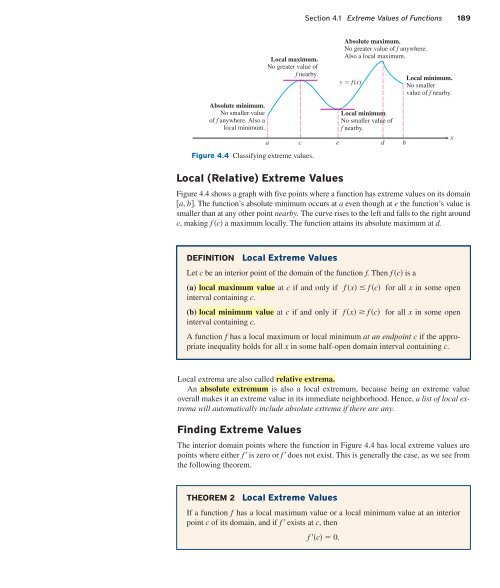5128_Ch04_pp186-260
Create successful ePaper yourself
Turn your PDF publications into a flip-book with our unique Google optimized e-Paper software.
Section 4.1 Extreme Values of Functions 189<br />
Absolute minimum.<br />
No smaller value<br />
of f anywhere. Also a<br />
local minimum.<br />
Local maximum.<br />
No greater value of<br />
f nearby.<br />
Figure 4.4 Classifying extreme values.<br />
Local (Relative) Extreme Values<br />
a<br />
y f(x)<br />
c e d<br />
Absolute maximum.<br />
No greater value of f anywhere.<br />
Also a local maximum.<br />
Local minimum.<br />
No smaller value of<br />
f nearby.<br />
Figure 4.4 shows a graph with five points where a function has extreme values on its domain<br />
a, b. The function’s absolute minimum occurs at a even though at e the function’s value is<br />
smaller than at any other point nearby. The curve rises to the left and falls to the right around<br />
c, making f c a maximum locally. The function attains its absolute maximum at d.<br />
b<br />
Local minimum.<br />
No smaller<br />
value of f nearby.<br />
x<br />
DEFINITION<br />
Local Extreme Values<br />
Let c be an interior point of the domain of the function f. Then f c is a<br />
(a) local maximum value at c if and only if f x f c for all x in some open<br />
interval containing c.<br />
(b) local minimum value at c if and only if f x f c for all x in some open<br />
interval containing c.<br />
A function f has a local maximum or local minimum at an endpoint c if the appropriate<br />
inequality holds for all x in some half-open domain interval containing c.<br />
Local extrema are also called relative extrema.<br />
An absolute extremum is also a local extremum, because being an extreme value<br />
overall makes it an extreme value in its immediate neighborhood. Hence, a list of local extrema<br />
will automatically include absolute extrema if there are any.<br />
Finding Extreme Values<br />
The interior domain points where the function in Figure 4.4 has local extreme values are<br />
points where either f is zero or f does not exist. This is generally the case, as we see from<br />
the following theorem.<br />
THEOREM 2<br />
Local Extreme Values<br />
If a function f has a local maximum value or a local minimum value at an interior<br />
point c of its domain, and if f exists at c, then<br />
f c 0.












